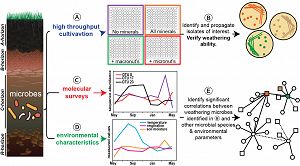Microbiology and Microbial Ecology of subsurface microbes: Paul Carini Research Group
Weathering processes aboveground and in surface soils have been relatively well studied, but we know far less about the factors that constrain weathering in deeper soils adjacent to parent materials. I employ a two-pronged approach to understand which microbial species are involved in weathering and to understand how their populations change through time. First, deep-dwelling soil microbes are isolated and assayed for their ability to weather minerals in the laboratory. Once weathering microbes are identified, molecular techniques are used to monitor the temporal population dynamics of these (and other) microbial species in the soils they were isolated from.
Image: Figure: Simplified illustration of the integrative approach that will be used to identifiy weathering microbes and understand their temporal ecology in the BcCZO. See text for details.
This group is tagged with:
-
The availability of soil nutrients is a key control on plant productivity and rates of ecosystem-level processes, including those processes associated with terrestrial carbon storage. However, in their native rock and mineral forms, many nutrients are biologically unavailable and need to be weathered (dissolved) in order to be assimilated by plants, animals and microbes. While the weathering processes aboveground and in surface soils have been relatively well studied, we know far less about the factors that constrain weathering in deeper soil horizons adjacent to parent materials. I employ a two-pronged approach to understand which microbial species are involved in weathering and to understand how their populations change through time. First, deep-dwelling soil microbes are isolated and assayed for their ability to weather minerals in the laboratory. Once weathering microbes are identified, I use molecular techniques to monitor the temporal population dynamics of these (and other) microbial species in the soils they were isolated from. The isolation and study of pure cultures enables hypothesis-driven experimentation necessary to directly link microbial species to specific geochemical processes. Molecular tools then allow us to ‘follow’ the abundances of these species, in the context of the entire microbial community, and to observe how their populations change over time. This combination of microbial cultivation with cultivation-independent molecular approaches yields unique insight into the diversity of subsurface microbes and their influence on mineral weathering rates.
-
Contacts
Alumni-Former
.(JavaScript must be enabled to view this email address)
CU-Boulder
CIRES
soil microbiology, rock and mineral weathering microbes, oligotrophic microbes
Explore Further


